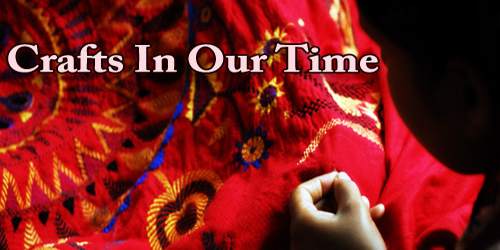Craftwork is an applied form of art, a social and cultural product reflecting the inclusive nature of folk imagination. A craftwork, which usually doesn’t hear the signature of its maker, retains a personal touch. When we look at a thirty year old “nakshikantha” we wonder at its motifs and designs that point to the artistic ingenuity and the presence of the maker in it. The fact, that we don’t know her name or any other details about her doesn’t take anything away from our appreciation of the artist. Indeed, the intimate nature of the kantha and the tactile feeling it generates animate the work and make it very inviting.
A craftwork is shaped by the interaction of individual creativity and community aesthetics utility functions and human values. It is distinguished by its maker’s desire to locate himself or herself in the wider and ever-changing cultural aspirations of the community, and subsequently of the market. But even when the market is an important factor, community aesthetics remains the factor determining the form and content of the craftwork. The exquisite terracotta dolls from Dinajpur dating back to early 1940s that form a part of the Bangladesh National Museum’s collection were mostly bought from village fairs by some patron. They were no doubt meant to be consumer items, but the dolls reflect community aesthetics in such a manner that the market has not been able to impose its own preferences on them.
A craftwork thus is a dynamic object-always evolving, and always abreast of changing tastes and preferences. It also represents a way of life and a cultural flavor. Therefore changes in lifestyle and material conditions are expected to have their impact on craftworks and their production. But certain forms, shapes, styles and aesthetic preferences change little overtime, suggesting that a craftwork can function as a stable signifier of community values and desires over time. Mechanical and mass production take away this feeling of assurance and stability and the sense of continuity that the handmade craftwork evokes.
In the clash between expectations of pure; handmade craftworks and the market need of mechanically produced craftworks, two contesting views emerge: on the one hand, traditionalists contend that the society needs to preserve the authenticity and naturalness of craftworks and their association with domesticity and environment; and, on the other, promoters of machine production argue that the machine has helped restore the appeal of the crafts due to their cheaper production costs.
There are no easy solutions to the problems that craftworks face in our time. Crafts that are disappearing can and should be revived, teen where the machine has made the prospect difficult. And crafts that are still practiced can be safeguarded and made to consolidate their position further. This can be done by providing grants, loans, assistance and other support to the producers, and helping them find a comfortable customer base.
But more importantly, craftwork can be branded and successfully marketed throughout the country and beyond as there are always buyers and users of handmade products who feel a strong attraction towards such cultural products.
















